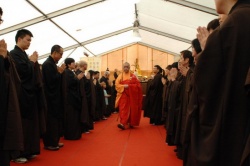Meditation and Visualization
How to focus your mind to benefit your body, plus 4 types of meditation by Sharon Cummings & Sheri Davenport
Meditation and visualization are empowering tools to enhance consciousness and self-awareness and to focus the mind. Visualization is a healthy way of bringing positive energy into your mind, body and spirit, expanding your capacity for creativity. Meditation and visualization experiences will vary; it is best to let go of expectations and surrender to your own inner wisdom.
Visualization in meditation
In meditation, the mind concentrates while the body relaxes; an effective position in which to begin visualization. You may find it helpful to consult visualization scripts or relaxation scripts before you try on your own. When the mind is clear and the body is relaxed, you can engage the imagination to visualize images and ideas. Meditation and visualization have the power to teach and heal. Visualization is one method of using the mind to influence the body.
Here is an example of an easy relaxation script for meditation: "Breathing in, I relax. Breathing out, I smile." Repeat this as long as you like, visualizing your body relaxing as you continue. Notice the physical changes.
Visualization benefits
Holistic Online cites many university studies showing that visualization has remarkable physical health benefits, including boosting immunity, easing depression, relieving insomnia, decreasing stress, and alleviating headaches and chronic pain. Often, seeing yourself healthy in your mind — or visualizing the image of a healthy body — is enough for your body to understand it as truth. If you are practicing visualization and meditation for health benefits, you should develop a daily practice to strengthen the communication between mind and body. There are numerous visual and audio visualization scripts available to guide your experience. Do not be attached to the results, but rather observe your personal journey.
Beginning visualization
To begin visualization:
Clear the mind completely. You may begin by concentrating on your breath.
Generate an image or idea in your mind before you begin visualization. Try using a general idea such as love, joy or a positive thought or affirmation such as, "I am balanced."
With each inhale, feel your body expand with potential, and exhale your positive thought into your world.
In the beginning, visualization may be repeating a mantra or concentrating on one positive image, but you can get creative with practice.
Creative visualization
Creative visualization, or guided imagery, is using the focus of the mind to create intentional thoughts or goals in your reality. When you can visualize an experience before you act on it, you are better prepared for the outcome. You may use creative visualization to affect your reality with your imagination, or you may choose to ground, relax or heal yourself.
Many visualization scripts invite you to imagine yourself in a safe, soothing natural environment like a sunny beach or wooded forest, where you can tune in to the sights, sounds and smells of that special place. You are free to roam around this space and see what arises in your mind. Be open to what you see, and know that this place always exists for you to visit.
4 simple meditations
If you talk to 10 people who meditate, you’ll likely hear 10 different approaches to the practice. The truth is there is no right or wrong way to meditate; whatever works for you is the right way. But there are some common ways to get started. Here are five techniques for you to try, combine or adjust to your liking. Explore them all until you find the technique that speaks to you.
Breath meditation
Focusing on your breathing is the oldest and most basic meditation technique.
Start off by sitting comfortably (on a cushion, mat or chair).
Then, close your eyes, press your tongue to your palate, close your mouth and breathe through your nose.
Inhale deeply into your abdomen.
Exhale through a slightly open mouth until your lungs are empty. Focus on your breath as you inhale and exhale. Count breaths if that feels right.
The goal is not to think about your breath but to quiet your mind and simply become aware of it.



